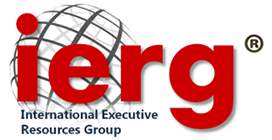Spotlight: IERG Texas Chapter - Blue Growth, Leveraging Water Management for Business Attraction & Operation
Spotlight: IERG Texas Chapter - Blue Growth, Leveraging Water Management for Business Attraction & Operation

On November 7th the Texas Chapter of IERG (International Executive Resources Group) hosted Chris Cameron as a virtual speaker. Chris is both a long-time global supply chain / logistics executive and, in the last 4 years, he has been applying those skills to addressing water management issues as they affect supply chains and manufacturing.
Water: The Invisible Constraint in Regionalizing Supply Chains
As global supply chains continue to evolve, many executives are turning to regionalization to enhance resilience, reduce costs, and respond to shifting market demands. However, a crucial and often underestimated factor is reshaping the decision-making process: water. Chris Cameron’s recent presentation, “Blue Growth: Leveraging Water Management for Business Attraction & Operation,” sheds light on the profound impact of water availability, management, and sustainability on business site selection and operations.
Water: A Critical Business Resource
Cameron’s presentation outlined a stark reality: water constraints are no longer an issue solely for agriculture or heavy industries. They are rapidly becoming a pivotal consideration for all businesses. For executives evaluating locations for new facilities, water scarcity or poor water quality can present significant risks to production, logistics, and long-term operational viability.
With businesses increasingly striving to regionalize supply chains to mitigate global risks, water access is emerging as a deciding factor. Cameron emphasized, “A lack of reliable water resources can jeopardize investments in facilities and disrupt operations,” pointing to regions where water scarcity has already led to production halts and increased costs.
The Challenge of Regionalization
While regionalization aims to bring supply chain functions closer to their markets, Cameron’s analysis highlights how water can upend this strategy. As companies attempt to distribute operations across multiple regions, they face stark disparities in water availability and infrastructure readiness. Regions with robust water management systems are at a competitive advantage, making them magnets for businesses seeking sustainable growth.
Cameron cited examples of industries heavily reliant on water, such as manufacturing, food processing, and technology. These industries often discover too late that water limitations can hinder their ability to scale or even operate efficiently. “It’s not just about water quantity,” Cameron noted. “Water quality and the infrastructure to deliver it are just as critical.”
The Financial Implications
The presentation brought the economic costs into sharp focus. Water-related risks, including supply interruptions, regulatory challenges, and rising costs for treatment and infrastructure, can have cascading effects on a company’s bottom line. Cameron outlined how companies investing in regions with poorly managed water resources often face unforeseen expenditures, from upgrading local water infrastructure to complying with stringent regulations.
He also highlighted the opportunities for regions with advanced water management systems. Cities and states that proactively address water sustainability are better positioned to attract businesses and support long-term economic growth. These areas offer predictability—a key factor for executives planning large-scale investments.
Proactive Solutions: What Executives Can Do
Cameron’s presentation wasn’t just a warning; it was a call to action. He provided actionable strategies for executives to navigate these challenges:
- Incorporate Water Audits in Site Selection: As a tenant or developer, know your water constraints and regulations early……before committing to a site. Businesses must evaluate water availability and infrastructure as rigorously as they assess labor, taxes, or transportation. Water audits can identify potential risks and hidden costs early in the process.
- Engage with Local Authorities: Understanding regional water policies and regulations is crucial. This begins by assign the responsibility of understand water management and technologies. And continues by knowing the water constraints in your area and the potential the operational fees that could impact your business. Partnering with local governments can provide insights into long-term sustainability plans and possible incentives for water-efficient operations.
- Invest in Sustainable Practices: A good rain does not solve your problems…if you let all the water run downstream. Companies can mitigate risks by adopting circular water-saving technologies and practices. From recycling wastewater to leveraging smart water management systems, innovation can turn water challenges into competitive advantages. Collaborative efforts often yield better outcomes than isolated investments.
- Market How You Use Water: Toyota applied water innovations in it’s North American headquarters building in Frisco, Texas. Immediately after touting the obligatory job growth they brought to the region, they marketed their sustainability of how they their rainwater harvesting from the headquarters’ rooftop is sustainable, generating 400,000 gallons of water for irrigation. This is a key practical message to their product & environmental marketing.

A Strategic Imperative for the Future
As Cameron concluded, water is not just an operational consideration; it’s a strategic imperative. Executives must integrate water risk into their decision-making frameworks, treating it as a critical component of site selection and supply chain strategy. Those who do will position their companies for sustainable growth in a world where water constraints are no longer a distant concern but an immediate reality.
“Regions that prioritize water management today will define the business landscape of tomorrow,” Cameron emphasized. For business leaders, understanding and addressing water challenges is not just an environmental responsibility—it’s a competitive necessity.
This article serves as a wake-up call to executives across industries. Whether building new facilities or optimizing supply chains, the message is clear: water matters. Ignoring its significance could leave companies high and dry—figuratively and literally. By taking proactive measures and aligning with regions committed to sustainable water solutions, businesses can ensure their operations flow as smoothly as their ambitions.





